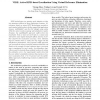Free Online Productivity Tools
i2Speak
i2Symbol
i2OCR
iTex2Img
iWeb2Print
iWeb2Shot
i2Type
iPdf2Split
iPdf2Merge
i2Bopomofo
i2Arabic
i2Style
i2Image
i2PDF
iLatex2Rtf
Sci2ools
ICPP
2007
IEEE
2007
IEEE
VIRE: Active RFID-based Localization Using Virtual Reference Elimination
RFID technologies are gaining much attention as they are attractive solutions to many application domains. Localization based on active RFID technologies provides a much needed added-value to further expand the application domain. LANDMARC was the first attempt using active RFID for indoor location sensing with satisfactory results. However, the LANDMARC approach suffers from two drawbacks. First, it does not work well in a closed area with severe radio signal multi-path effects. Second, to further improve the localization accuracy, more reference tags are needed which is costly and may trigger the RF interference phenomenon. The proposed VIRE approach can overcome the above drawbacks without additional cost. Based on the concept of virtual reference tags, a proximity map is maintained by each reader. An elimination algorithm is used to eliminate those unlikely locations to reduce the estimation error. Our experimental results show that the new method consistently enhances the precisi...
Active Rfid | Application Domain | Distributed And Parallel Computing | ICPP 2007 | RFID Technologies |
| Added | 03 Jun 2010 |
| Updated | 03 Jun 2010 |
| Type | Conference |
| Year | 2007 |
| Where | ICPP |
| Authors | Yiyang Zhao, Yunhao Liu, Lionel M. Ni |
Comments (0)

